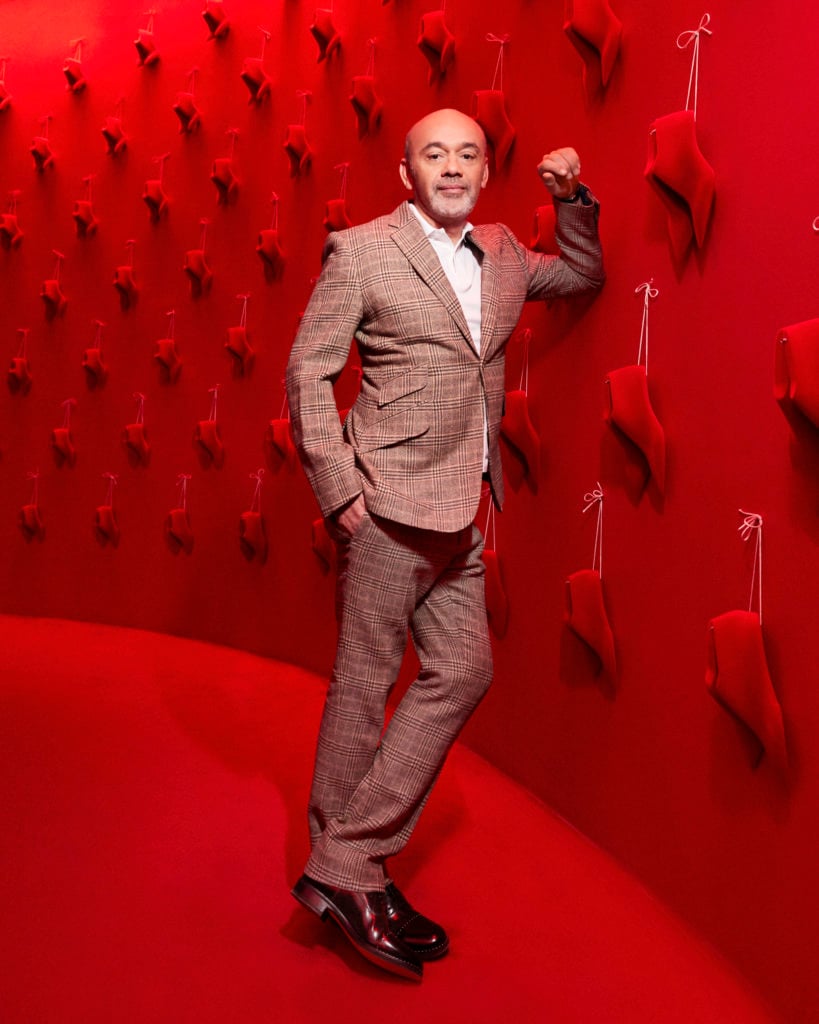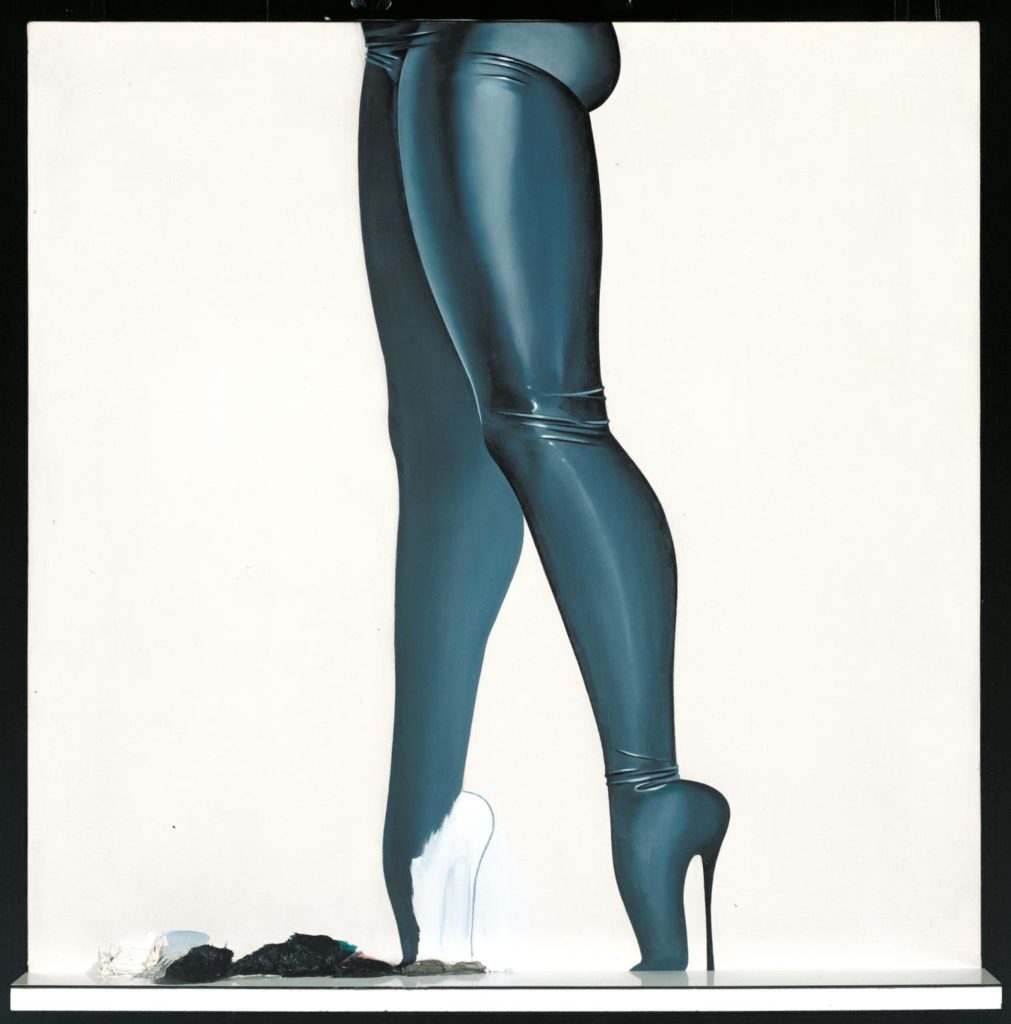On View
Shoe Designer to the Stars Christian Louboutin on How Warhol Inspired His First Red-Soled Heel and Why He Calls Himself an ‘Applied Artist’
Louboutin's new show in Paris showcases the designer's own work and that of his artistic influences.

Louboutin's new show in Paris showcases the designer's own work and that of his artistic influences.

Naomi Rea

What shoes should one wear to meet Christian Louboutin?
That’s what I was wondering as I made my way to interview the designer behind the red-soled heels favored by celebrities and royalty, and who is now the subject of a sweeping exhibition at the Palais de la Porte Dorée in Paris.
The show, titled “L’Exhibition[iste],” contains more than 400 pairs of shoes, from Louboutin’s early designs through the nascence of the iconic red sole to his more recent “unwearable” sculptural shoes. It’s a testament to his career as a designer, but at the same time, Louboutin tells Artnet News, the exhibition had to be about “more than just shoes.” (Hopefully that means he forgave my hasty 5 a.m. decision to wear scruffy boots to our meeting.)
“The shoes are the tip of the iceberg,” Louboutin says. “A lot of things came before that.”
Indeed, the show includes biographical elements relating to the designer, as well as new installations from contemporary artists including Imran Qureshi and Lisa Reihana. At the end of the exhibition, the designer has put together what he calls his “imaginary museum,” a selection of artworks, ranging from tribal masks to pop art, that represent some of his own artistic inspirations.
![Exhibition view, Christian Louboutin: "L’Exhibition[niste]," Palais de la Porte Dorée. ©Marc Domage.](https://news.artnet.com/app/news-upload/2020/02/Exhibition-view-Christian-Louboutin-L%E2%80%99Exhibitionniste-Palais-de-la-Porte-Dore%CC%81e-%C2%A9-Marc-Domage-3-1024x698.jpg)
Exhibition view, “Christian Louboutin: L’Exhibition[niste],” Palais de la Porte Dorée. ©Marc Domage.
In the works for three years, the show was curated by the director of Paris’s Musée des Arts Décoratifs, Olivier Gabet, who agrees with Orain about the “universal impact” of fashion.
“It brings together artistic and social values, a kind of paradoxical inclusiveness—it seems reserved to an elite, but it is a dream for all—and a strong sense of openness to all,” Gabet tells Artnet News. He says this is particularly important when more and more people are feeling alienated by inaccessible museum shows.
“So many artworks, especially in contemporary art, or very classical art, are nowadays very difficult to understand for many people, due to the overwhelming conceptual array of historical and symbolic references,” he says.
Louboutin tells Artnet News that he grew up nearby the museum in an unassuming working-class neighborhood, and has been visiting since he was a child. “I owe a lot to this building,” he says.
Back then, the museum was dedicated to African and Oceanic Art, most of which has since migrated to the Quai Branly museum. The Art Deco building was originally built in 1931 for a colonial exhibition in Paris, and it shows. The façade features a bas-relief of Africans and French colonists that today might be read as an offensive relic of imperialism.
Louboutin admits that as a young child he was “too scared” to enter the building, but that he was eventually persuaded by his sister to cross its threshold when he was around nine years old. He was enchanted by the treasures held within, from tribal masks to Ancient Egyptian artifacts, and was utterly taken by the aquarium located in the basement. “It was my first way to travel before I ever got the chance to do it in real life, and I was inspired,” he says.

Information panel and crucial drawing at the origin of Christian Louboutin’s vocation. © Christian Louboutin.
Indeed, it was inside the museum that the designer saw his first drawing of a shoe. An outline of a 1950s-style stiletto in profile had adorned a sign forbidding people to wear high heels in the museum in order to protect the mosaic floor. The shape of the shoe was unfamiliar to a kid growing up in the 1970s, and Louboutin credits it with initiating his vocation.
The artistic inspirations on view in the exhibition are rather eclectic, from a selection of blue and white Wedgwood porcelains to a Damien Hirst work from his Venice blockbuster to an Oscar Niemeyer bench to Pop art works, including a piece from Andy Warhol’s “Flowers” series. The first shoe to be decorated with Louboutin’s signature red sole was actually a prototype which had a buckle inspired by a Warhol flower. As the story goes, Louboutin had a eureka moment when he saw his assistant painting her nails red. He borrowed the polish to lacquer the sole of the shoe, and the rest is history.
Asked what types of artworks inspire him, Louboutin says that it is all about work that can speak to his “inner child.”
“I’m more attracted by things in art that are not so mature that they cannot still speak to a child,” Louboutin says. “There has to be something in the artist’s world that is accessible.” He says he has always been attracted to the cartoon-y style of artists like Clovis Trouille and Eyvind Earle, who was an early illustrator for Walt Disney’s animations.

Allen Jones, Wet Seal (1966).
“I always questioned this element of respect for big, noble art that depends on it being detached from any function,” Louboutin says. He talks about the talent of the Giacometti brothers, and the fact the Diego has always had less acclaim than his older brother Alberto because he made “art that you can sit on.”
“I never really understood why having a function for an art piece makes it any less noble,” Louboutin says.
Louboutin says that he has the same relationship with shoes as he does with works of art, and he considers himself to be an “applied artist.” Some of the most interesting shoes on view are a series of impossible shoes that Louboutin made for a collaboration with the filmmaker David Lynch. The artist photographed women wearing them, a set of conjoined heels, or pointe shoes with a sky high heel, as part of a 2007 series called “fetish.” These shoes are closer to sculpture than to functionality, but Louboutin says they shouldn’t necessarily be considered “art” any more than the shoes he designs for the red carpet.
Some of the works on view have come from Louboutin’s own home, but he doesn’t see himself as a collector. “A collector is someone who wants to perform in a way, who is pretty obsessed with having a piece which fits into their collection,” he says, adding that he has never sold anything in his collection. “Me? If I like an object or I like a painting, then I might buy it. But it’s never in reference to another piece, or because I want the best painting of this other artist. It’s just an instinctive moment.”
The exhibition includes new installations from artists including a group of nine leather mannequins in different skin-tones created by the British artist duo Whitaker/Malem. There is also a video work by Lisa Reihanna, stained-glass pieces by La Maison du Vitrail, and a rather shocking installation by the Pakistani artist Imran Qureshi featuring a gold-leaf-clad shoe in what appears to be a pool of blood.
It’s not exactly the branding association you would expect to be welcomed by a high-heel shoemaker. Indeed, Louboutin says he was “surprised” by the result. They had discussed a vision of red and gold in the beginning of the collaboration, and he had actually been expecting one of the artist’s delicate miniatures. But he says that he is not upset that the artist went in a different direction.
![Imran Qureshi, <i>This too will end, if you go on a step or two</i> (2019). Exhibition view "L’Exhibition[niste]," Palais de la Porte Dorée. ©Marc Domage.](https://news.artnet.com/app/news-upload/2020/02/Imran-Qureshi-This-too-will-end-if-you-go-on-a-step-or-two-2019-Exhibition-view-L%E2%80%99Exhibitionniste-Palais-de-la-Porte-Dore%CC%81e-%C2%A9-Marc-Domage-1024x682.jpg)
Imran Qureshi, This too will end, if you go on a step or two (2019). Exhibition view “L’Exhibition[niste],” Palais de la Porte Dorée. ©Marc Domage.
From the runway to the high street, fashion brands are collaborating more often with artists who can bring a certain cachet to help define and enrich a brand. But Louboutin says that any collaboration that he does “needs to be natural.”
“It needs to be organic. I’ve never done a collaboration for its own sake,” he says. “I have a brand, but I have never considered it in this cynical way.”
While it is all well and good when an artist does something unexpected as part of a collaboration, Louboutin admits that it can be “annoying” when an artist or another brand copies his designs, or uses them in a less than flattering light.
The company is known for fiercely protecting its trademark, although Louboutin says that he personally prefers not to engage with the offenders. “I’m pretty much an enthusiastic person and a very positive person, so for everything that is negative, I’m a bit of an ostrich. I’d rather not look at it,” he says. “That’s sort of my way to not feel too annoyed by these things, like forms of copy or trashing someone else’s work. Sometimes I just prefer not to know.”
“L’Exhibition[iste]” runs at the Palais de la Porte Dorée in Paris through July 26.